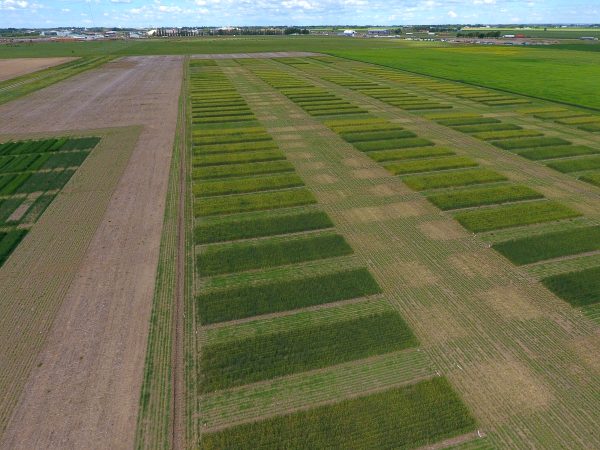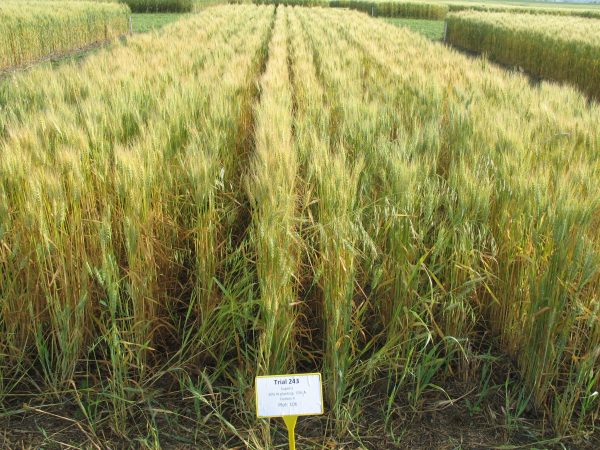
Features
Fertility and Nutrients
Exploring EEFs to reduce nitrous oxide emissions
Meeting national emissions reduction targets for fertilizers
June 6, 2022 By Donna Fleury
Implementing good management practices to reduce greenhouse gas emissions from fertilizers is a priority for the agriculture sector, together with agronomic and economic performance targets. A recent national reduction target for emissions from fertilizers is set at 30 per cent below 2020 levels by 2030. Agriculture is the dominant source of nitrous oxide (N2O) emissions, accounting for nearly 70 per cent of emissions of the gas in Canada and globally. N2O is released from soil during the cycling of nitrogen, with the addition of fertilizers, livestock manures, and crop residues potentially leading to emissions. Researchers and industry are considering practices in the agriculture sector to help reduce greenhouse gas emissions from fertilizer, enhance carbon sequestration, and complement the 4R nutrient management stewardship program.

Winter wheat trials at Agriculture and Agri-Food Canada Lethbridge Research station comparing different timing and placement options of various enhanced efficiency urea fertilizer (EEF) products. Photo courtesy of Warren Taylor, AAFC Lethbridge.
“Our research program, in part, is focused on cropping practices and alternatives that could help mitigate greenhouse gas emissions, particularly N2O from fertilizers,” says Brian Beres, senior research scientist – agronomy, Agriculture and Agri-Food Canada (AAFC) in Lethbridge, Alta. “There are different ways to measure emissions reductions or carbon sequestration, and we are trying to determine if indicators or proxies could be developed to show if adopting a practice would work or not. We want to know if there are practices within a spring wheat (CWRS) or winter wheat system, for example, that could be adopted and would address or fully meet the emission reduction targets that have been set. This is what farming and agronomic research are all about, to find a way to stack or weave these increments together so they all of a sudden have a transformational shift in something.”
Beres is also investigating whether winter wheat could be positioned as a cropping practice alternative to the vast acres currently devoted to spring wheat on the Prairies, and what the implications would be of switching over to a winter habit instead. There are supporting models that indicate warming conditions as a result of climate change, potentially due to higher CO2, may favor a winter growth habit that is better synced with a shifting availability of resources such as water and soil nutrients earlier in the growing season.
“So far our preliminary research results seem to correspond quite well with the findings of other global studies at a meta-analysis level and western Canadian studies, such as those conducted at the University of Manitoba in Mario Tenuta’s Applied Soil Ecology Lab,” explains Beres. “For example, our research on spring wheat to date suggests that by simply switching from uncoated urea to the use of one treated with an enhanced efficiency fertilizer form (EEF), primarily nitrification inhibitors, could reduce emissions by 30 per cent or more, meeting or exceeding the reduction targets currently in place. It is pretty encouraging to see that the environmental performance targets are achievable, however, more conversations and research efforts into yield and economic performance targets are needed. Enhanced efficiency fertilizers may improve N use efficiency, but they are more expensive than conventional fertilizers.”

Research suggests that split-applications of N might be most efficient for yield and protein optimization when combined with an EEF product, particularly with urease or urease+nitrification inhibitors, and if the majority of N is applied in spring. Photo courtesy of Warren Taylor, AAFC Lethbridge.
In the winter wheat study conducted by Beres and colleagues across Western Canada, the results showed incremental increases in grain yield and protein from using EEF forms of N that included a urease inhibitor or urease and nitrification inhibitors relative to other N sources, regardless of application and timing. The study showed that EEFs can be applied during seeding operations and broadcast in-crop in early spring with reasonably low risk and no yield penalty. However, the results also suggest split-applications of N might be most efficient for yield and protein optimization when combined with an EEF product, particularly with urease or urease+nitrification inhibitors, and if the majority of N is applied in spring. Including a urease inhibitor in the N fertilizer formulation will improve N uptake and enhance agronomic performance in the winter wheat systems.
“Although our results showed greater gains in yield and better returns in winter wheat when using EEF, the results so far for environmental indicators such as N2O fluxes were flat across all of the treatments,” adds Beres. Emissions of N2O from soil are typically expressed simply as flux across a surface. “However, this could be an artifact of growth habit as flux magnitude was lower compared to CWRS, which had both elevated levels and a notable positive response to lowering those levels when EEFs with a nitrification inhibitor were used. This could be because a winter wheat system doesn’t leak as much nitrogen as a spring wheat system and therefore did not reach a threshold where EEF responses are more apparent, but that is speculation on our part, so it is worthy of more investigation. Using EEF forms is not just about reducing fluxes in N2O, but better yields and higher protein all suggest better N uptake and are linked together. However, there can be a financial burden to using EEF forms known to reduce N2O fluxes, and perhaps there needs to be a cost-sharing mechanism acknowledging the benefit to society as well. There needs to be a conversation on the production side on how to manage the extra investment that may meet policy and society needs, but doesn’t always meet production and economic outcomes of the farmer, particularly as fertilizer prices rise.”
Mario Tenuta, 4R Nutrient Stewardship Industrial Research Chair, Applied Soil Ecology Lab at the University of Manitoba agrees. “Our research conducted primarily in the Red River Valley and central Manitoba, along with collaborations with the University of Saskatchewan, and the work of Brian Beres and his AAFC colleagues, all clearly indicate that using EEF forms of N can substantially reduce N2O emissions, showing as much as 30 to 50 per cent reductions. However, looking at the agronomics, increasing yield using EEF forms can be more challenging. Producers tend to use optimal or sufficient rates of N in their cropping systems, so in a year when N losses are low, farmers won’t see a big benefit in yields from using EEF, and sometimes they won’t see a yield benefit at all. In some years, there can be benefits other than yield, such as higher protein in spring and winter wheat.”
However, farmers are going to need a mechanism by which to pay off the premium cost of inhibitor products. Without higher yields or protein advantages, there would need to be some other avenue for incentives to invest in these EEF forms. “There is a premium cost for EEF compared to urea depending on the product of upwards to 20 per cent,” Tenuta says. “This is an extra cost that needs to be incentivized. Some options under discussion include direct assistance to growers to encourage the use of EEF fertilizers. Another option could be voluntary market mechanisms, where companies that want to offset emissions in their business could purchase credits in another sector such as agriculture. Farmers could provide documentation of expected N2O reductions from fields using EEF based on our western Canadian research, and then sell that offset or credit into the market. The markets will dictate what documentation will be required, with better datasets across the Prairies supported by our research to help meet the requirements.”
Research demonstrates other fertilizer management practices that can help mitigate N2O losses and improve efficiency. “Trying to shift to spring application is important, which is not a problem in many regions of the Prairies,” Tenuta says. “In wetter, more humid areas such as eastern Manitoba, where fall anhydrous application is fairly common, switching to spring application where possible, or to fall application as late as possible to reduce the risk of N2O emissions is recommended. We have research underway looking at a tag team of fall application and nitrification inhibitors to see if there are benefits. If switching to spring application, minimizing ammonia losses is also important and using a urease inhibitor can be an option, if there is no other option than to surface apply.
“In another study just completed with canola, our research shows that shallow banding fertilizer 3/4 to 1 inch deep could lead to more N2O emissions. Therefore, either surface application with incorporation or deep banding, either side or mid-row, down to 3 to 4 inches is better and reduces the risk of N losses. Split applications can be beneficial for crops such as winter wheat or longer-season crops, such as corn and potatoes. One of the benefits of a split application is the timing of the second application to top up N is generally when soils are a bit drier and less conducive to N2O emissions.”
As plans get underway for the next Canadian Agricultural Partnership (CAP) Agri-Science Research Clusters starting in 2024, Tenuta, Beres and a network of researchers propose to include more studies around best management practices for agronomic and environmental performance across different geographic areas of the prairies to meet climate change targets. “Our sights are on how we can get to another level beyond the current reduction targets of 30 per cent for fertilizers,” Tenuta adds. “We need to be strategic in establishing studies across multiple locations and a range of moisture and temperature gradients across the Prairies to be representative of where farmers grow food. We are very optimistic that we can meet environmental performance and agronomic goals with best practices without having to reduce our N usage in the future.”